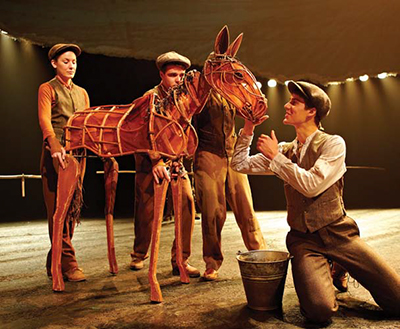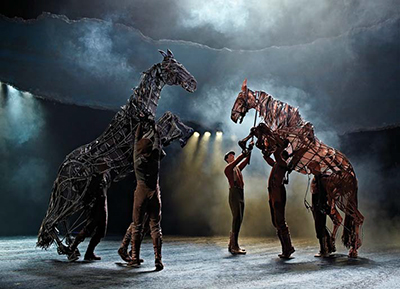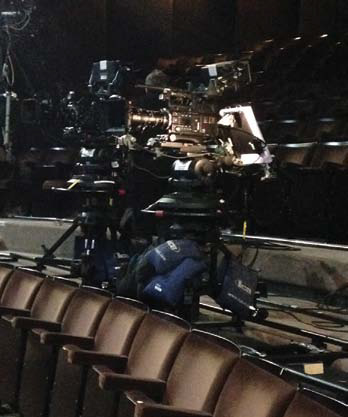4K ‘War Horse’ Transmitted Live From London Stage

LONDON—Joey the War Horse, who has already warmed the hearts of 5 million people as a theatrical experience, has now made technical history with a live 4K transmission into one London cinema, while simultaneously hitting over 1,000 screens in 30 nations as an HD feed.
The big achievement technically was shooting a performance at the New London Theatre in Drury Lane, and using 36 MHz of capacity on SES Astra’s 3B satellite to deliver the image quadrants to the Curzon Cinema in Chelsea, perfectly synced.
The key drivers behind this project for National Theatre Live were Producer Emma Keith and her Technical Partner, Creative Broadcast Solutions’ Chris Bretnall, who has worked on a number of high-profile theatre events since 2005. Keith joined NT Live in 2009 and cut her teeth with HD projects like “The Audience” starring Helen Mirren, and “Macbeth” starring Kenneth Branagh. The jump to 4K required the support of Bretnall and NT Live’s other regular contractors NEP Visions and Link Broadcast, plus Sony for the provision of many key services. Director Tim van Someren called the multi-camera shoot.
THE PRODUCTION TALE
To Emma Keith the extra technical challenges were negated by the rewards. “It is great for us to be doing something innovative at the forefront of the technology. NT Live is all about recreating that theatre experience, so we produce it ourselves, and never bring in external production companies,” she said. “We work with TV lighting director Bernie Davis, and he adapted the ‘War Horse’ theatre lighting so it works on camera.

“War Horse” is based on a book of the same name by acclaimed children’s author Michael Morpurgo. “There is a lot of projection in this show and we put in brighter projectors for this broadcast. There is a lot of haze, and a lot of other things that interrupt the light getting back to the lens, so we had to make tweaks,” she added. “But the idea with NT Live is that it looks on camera like it would if you were watching the show on stage. It is not about recreating it, but obviously you have to do things to make it look the same through the camera. Particularly with 4K the haze is picked up more, and it does look noisier”
Make-up changes are also common. “The biggest thing on this show concerned the wigs and facial hair,” according to Keith, who added that the problem was resolved by remaking the props with lace that could stand up to the rigors of high-definition.
“The show doesn’t have a huge amount of make-up in it, but there were issues,” she added. “This involved things like when they are at war in the second half, and are covered in mud. A lot of that had to be worked on so it came across right in 4K.”
Get the TV Tech Newsletter
The professional video industry's #1 source for news, trends and product and tech information. Sign up below.
NT Live is very sensitive to the artistic integrity of any original piece, and that helps the actors to get on board.
“We do two full rehearsals before we go live, so they are able to get used to the cameras,” said Keith. “They already have radio mics, although some of the positions were changed, and some of the mics had to be upgraded so you do cannot see them easily. We worked with the theatre sound, but had a truck outside doing the live 5.1 mix for cinemas.
“The first camera rehearsal was a couple of weeks before the big night and we went back and watched it on a cinema screen in 4K to make sure we were happy with the camera placements, lighting and mic placement,” she added. “The rehearsal on the day before was an opportunity to make sure we were capturing everything we needed, and were telling the story. It also told us that the technology was working. There is an ambition that we will move to 4K, but the infrastructure and the technology has got to be at the cinema end for it to make the investment worthwhile.”
THE DIRECTOR’S ROLE
Director Tim van Someren highlighted the visual clarity of 4K.
“The picture is so clear and sharp, more information can be gained by the viewer,” he said. “Knowing our audience would entirely be watching in cinemas on a physically big screen, and knowing that [those watching in 4K] would be able to get so much visual information from that image meant I could include more wide shots,” he said. “On the other hand, it exposes so much reality that you have to be careful not to reveal too much that jars the viewer from enjoyment of the story by reminding them that it’s a staged event.
“We are at an advantage that the viewer is well aware they are watching a theatre play, not a movie, so we can’t be completely perfect in this aspect, but we worked harder than ever to minimize the impact of these things, as much as practically possible. For example, we might like to remove a tape mark on the stage, but if that means the tank doesn’t know where to turn, or Joey doesn’t stop in the right spot for a lighting cue, that hasn’t really helped the production,” he added. “So we worked with stage management to make such marks less prominent but still useful. The cameras gave us a greater dynamic range, which was generally useful in terms of balancing lighting and projection, but this would have been the case in 1080 as well as 4K. But it was an improvement over traditional HDTV cameras.”
Van Someren says the F55 has already proved itself. “The main technology leap was the camera-backs that sent the pictures to the gallery, gave the operators return vision tally lights, and allowed remote picture and iris control,” he said. “I always use my own nominated camera crew, as do most multi- camera directors. On any multicamera shoot, you need specialist operators. This is the case whether you are shooting sports, music, drama or entertainment,” he added. “To be a camera operator on an NT Live project is possibly one of the most demanding jobs around, and I had some of the best operators in the UK.”

These Sony F55 cameras had the best seat in the house, so cinema audiences could get the best possible view of the show.
THE ENGINEERING FACTORS
Chris Bretnall (of Creative Broadcast Solutions) made his initial feasibility studies into 4K technologies in November. What made him think they were mature enough to deploy?
“I am not sure they were, in fact, ready when we decided to go for it, but I took a calculated risk in continuing with the plan,” he said. “Discussions with peers and vendors kept me informed of the chance of pulling it off. The projector readiness was a different story: this was on a knife-edge right until the last moment.” What technical issues did he have to resolve during the project?
“We normally have to sync the HD pictures to the delayed Dolby Digital. For the 4K transmission we first had to sync the four quadrants of the picture and also embed the DD onto the quads too,” said Bretnall. “Another challenge was making sure the quads stayed perfectly timed coming out of the decoders in the cinema and into the (SRX-R515P) projector. The DD audio then had to be resynchronized to match the delay in the cinema decoder/processor.”
Having done one 4K project, how soon does Bretnall think the knowledge accrued will trigger regular 4K live events? “The cinema is a ready-equipped environment for 4K production workflows. I am now waiting for the kit to be available commercially within the OB community,” he said.
NT Live has plans for further 4K movie house incursions with 4K DCP masters, and they got NEP Visions to record 4K ISOs for later use as well.
Asked what issues that company had encountered, NEP Visions Technical Manager David O’Carroll said, “nothing that we didn’t foresee. The way 4K is being treated is just an extension of established HD 3G workflow.”
His colleague Brian Clark, the commercial and technical projects director added, “this was a milestone. Basically this was the perfect solution of available people, available kit and viable content. Everybody will wait to see how 4K will develop, but it will find a market.”
Among the many issues involved, Clark picked on the logistics of getting a flypack into a tiny space, and resolving lip sync issues caused by the handling of 1080p, 1080i and PAL elements and their different delays. “This just required methodical checking of the signal path,” Clark said. “Picture sync was a problem too, as the broadcast quadrants had to line up for the projector.”
Mark Grinyer, program manager World Cup 2014 for Sony concurred. “The NT Live production team pushed us really hard to make this happen. Getting into the projector was the key area.”
